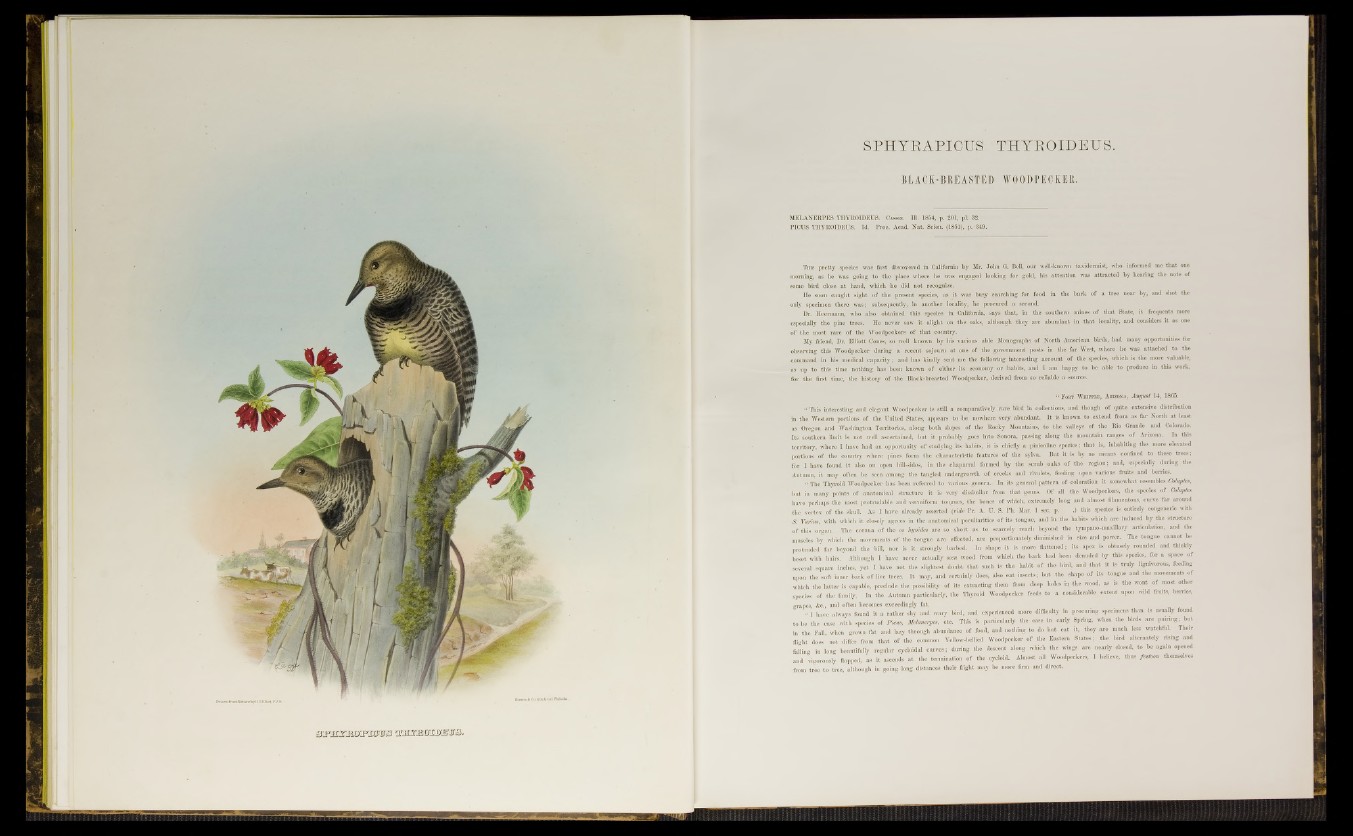
S K u a n B M P in n r a MnMMMVRi
SPHTEAPICUS THYEOIDETJS.
B LA C K - B R E A S T E D WO O D P E C K E R .
MELANERPES THTROIDEUS. Casein. HI. 1854, p. 201, pi: 82;
PICUS THYROIDEUS. Id. Proc. Acad. Nat. Scien. (1851), p.-349.
This pretty species was first discoyered in California by Mr. John G. Bell, oiir well-known taxidermist, who informed me that one
morning, as he was going to the place where he was engaged looking for gold, his attention was attracted by hearing the note of
some bird close at hand, which he did not recognize.
He soon caught sight of the present species, as it was busy searching for food in the bark of a tree near by, and shot the
only specimen there was; subsequently, in another locality, he procured a second.
Dr. Heermann, who also obtained this species in California, says that, in the southern mines of that State, it frequents more
especially the pine trees. He never saw it alight on the oaks, although they are abundant in that locality, and considers it as one
o f the most rare of the Woodpeckers of that country.
My friend, Dr. Elliott Cones, so well known by his various able Monographs of North American birds, had many opportunities for
observing this Woodpecker during a recent sojourn at one of the government posts in the far West, where he was attached to the
command in his medical capacity; and has kindly sent me the following interesting account of the species, which is the more valuable,
as up to this time nothing has been known of either its economy or habits, and I am happy to be able to produce in this work,
for the first time, the history of the Black-breasted Woodpecker, derived from so reliable a source.
■ “ P ort Whipple, Arizona, August 14, 1865.
" This interesting and elegant Woodpecker is still a comparatively rare bird in collections, and though of quite extensive distribution
in the Western portions of the United States, appears to be nowhere very abundant. It is known to extend from as far North at least
as Oregon and Washington Territories, along both slopes of the Rocky Mountains, to the valleys of the Rio Grande and Colorado.
Its southern limit is not well ascertained, but it probably goes into Sonora, passing along the mountain ranges of Arizona. In this
territory, where I have had an opportunity of studying its habits, it is chiefly a pinicoline species; that is, inhabiting the more elevated
portions of the country where pines form the characteristic features o f the sylva. But it is by no means confined to these trees;
for I have found it also on open liill-sides, in the chaparral formed by the scvub oaks of the region; and, especially during the
Autumn, it may. often be seen among the tangled undergrowth of creeks and rivulets, feeding upon various fruits and berries.
« The Thyroid Woodpecker has been referred to various genera. In its general pattern, of coloration it somewhat resembles Colaptes,
but in many points of anatomical structure it is very dissimilar from that genus. Of all the Woodpeckers, the species of Colaptes
have perhaps the most protrudable and vermiform tongues, the bones of which, extremely long and almost filamentous, curve‘far around
the vertex of the skull. As I have already asserted (vide Pr. A. U. S. Ph. Mar. 1 sec. p. ',} ;this species is entirely congeneric with
S. varius, with which it closely agrees in the anatomical peculiarities of its tongue, and in the habits which are induced by the structure
of this organ. The cornua of the os hyoides are so short as to scarcely reach beyond the tympano-maxillary articulation, and the
muscles by which the movements of the tongue are effected, are proportionately diminished in size and power. The tongue cannot be
protruded far beyond the bill, nor is it strongly barbed. In shape it is more flattened; its apex is obtusely rounded and thickly
beset with hairs. Although I have never actually seen wood from which the bark had been denuded by this species, for a space of
several square inches, yet I have not the slightest doubt that such is the habit of the bird, and that it is truly lignivorous, feeding
upon the soft inner bark of live trees. It may, and certainly does, also eat insects ; but the shape of its tongue and the movements of
which the latter is capable, preclude the possibility of its extracting them from deep holes in the wood, as is the wont of most other
species of the family. In the Autumn particularly, the Thyroid Woodpecker feeds to a considerable extent upon wild fruits, bemes,
grapes, &c., and often becomes exceedingly fat.
" I b a n always found it tt rather shy trad .vary bird, and experienced more difficulty in procuring specimens then is usually found
to be the cose with species of Pic»., df.ion.iy«, etc. This is particularly the ease in early Spring, when the birds are pairing; hut
in the Pall when grown fat and lazy through abundance of food, and nothing to do but eat f t they are much less watchful. Their
Sight does' not differ from that of the common Yellow-bellied Woodpecker of the Eastern States; the bird alternately rising and
(¡tiling in long beautifully regular cycloidal curves; during/the descent along which the wings are nearly dosed, to be again opened
and rigorously Happed, as it ascends at the termination of the cycloid. Almost all Woodpeckers, I believe, thus fe.toon themselves
from tree to tree, although in going long distances their flight may bo more firm and direct.